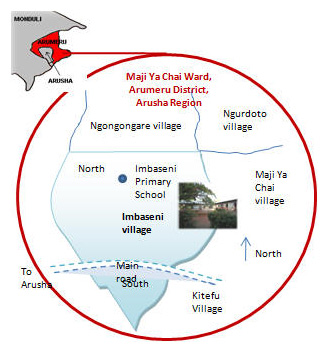10% of your purchase price will
be donated to Project
Imbaseni
Situated in East Africa, Tanzania is a beautiful country with a rich mix of natural resources and landscapes. Snowcapped Mt Kilimanjaro, the tallest mountain on the African continent, towers majestically over the horizon, flamingos stand sentinel in the salt pans of the Ngorongoro Crater, wildebeest thunder by the thousands over the Serengeti Plains, and Indian Ocean breezes caress the white sands of Zanzibar’s Spice Islands.
However, amidst these natural wonders, 17.5 million Tanzanian children live in the world’s worst poverty:
However, amidst these natural wonders, 17.5 million Tanzanian children live in the world’s worst poverty:
- The country’s $400 per capita GNI is less than 1% of the GNI in the US, and is one of the lowest in the world
- More than 45% of Tanzanian children survive on less than $1 a day
- Only 67% of these children finish primary school, and only 5% attend secondary school
- HIV prevalence is as high as 9%. It has claimed the lives of hundreds of thousands, leaving 1.2 million children orphaned, hungry, and searching for hope and a brighter future…
HOPE AND PROMISE FOR TANZANIA
Challenging as it is, Tanzania is also well positioned for change and development. Compared to many other African nations, Tanzania has:
- A stable political environment: Led by a highly popular ruling party, CCM, which has governed the country for the past 44 years, Tanzania transitioned successfully and peacefully to multi-party democracy in 2005. Tanzania does not have the internal political upheaval that has plagued so many other African nations.
- A harmonious society: Even though it is one of the most diverse nation in Africa, with more than 120 ethnic groups, there are no tribal conflicts. There are also virtually no conflicts with neighboring countries. Tanzania is referred to as the "Switzerland" of Africa, providing neutral meeting locations for other African nations.
- A stable GDP growth: GDP grew an average 4% in the mid to late 1990s, rose to 5.8% in 2000 and reached 6.9% in 2008. This growth was driven by non-agricultural sectors such as mining (15%), construction (10.2%), trade (7.2%), and communication (6.1%).
- A relatively controlled corruption status: Tanzania is currently rated above average for the region in terms of prevalence of corruption and is considered, by the World Bank, as one of the least corrupt of all heavily indebted poor countries
Overcrowded
classrooms
classrooms

- Average students per classroom is 60, but up to 100 students per classroom is common
- Interactive learning and individual attention from the teacher is impossible due to class size
Inadequate learning
materials
materials

- Up to 20 students share a textbook in some schools
- Reference books, labs, teaching and learning aids are in extremely short supply
Insufficient qualified
teachers
teachers

- More than 6,000 teachers are needed to fill current gaps
- Rural areas are unable to retain teachers due to difficult living conditions
- Teachers spend considerable time on second jobs due to insufficient teaching salaries.
Poor classroom
facilities
facilities

- Shortages of furniture, and blackboards are common
- There are a large number of unfinished classrooms without roofs or windows due to insufficient funds
- Electricity connection is rare for rural schools
AFFILIATED SITES

Project Imbaseni

501(c)3 partner
Bricks and Books
Foundations for
Learning in Tanzania
RECOMMENDED PRODUCTS
- Location
- The village of Imbaseni is located in Maji ya Chai ward, Meru district, Arusha region of Northern Tanzania. It is located 25 miles from Arusha, the hub of the safari and trekking industry, along the main roads, frequented by the tourists who travel to Mt. Kilimanjaro and the Ngorongoro Crater and other major attractions.
- History
 The first group of Meru residents name their village, Imbaseni, after a local plants that covered much of the land in the area. These pioneers built farms and family bomas, and opened the first road between Arusha and Mount Kilimanjaro. They called the river around their village, " Maji Ya Chai" (Tea water) due to dark brown color of the water. Today, "Maji Ya Chai" is the name of the ward, which includes Imbaseni and four of the neighboring villages.
The first group of Meru residents name their village, Imbaseni, after a local plants that covered much of the land in the area. These pioneers built farms and family bomas, and opened the first road between Arusha and Mount Kilimanjaro. They called the river around their village, " Maji Ya Chai" (Tea water) due to dark brown color of the water. Today, "Maji Ya Chai" is the name of the ward, which includes Imbaseni and four of the neighboring villages.
For a long period of time, Imbaseni suffered from a lack of clean water. Women had to walk 8 hours for drinking water. Many, who drank unsafe water, suffer from disease and disfigurement. With the help of local and international non-profit organizations, new water pipes and tanks have been installed, and a critical health issue has been resolved for the village. With this issue behind them, the members of the community are ready to overcome other challenges..- General information
-
- Population: 8,000-9,000, mainly Meru; 25% are children age 4-15
- Economic activities: The majority of the community members are small-scale farmers. Some retail or service operations exist in the southern portion of the village.
- Water conditions: Although recently resolved, the effect of serious water problems in the recent past are still freshly in evidence.
- Electricity: There is no connectivity other than in limited areas along the main road
- Educational facilities: There is one government Primary School in the northern part of the village, approximately two hour walk (one way) from the southern part. There is no secondary school in the village.







